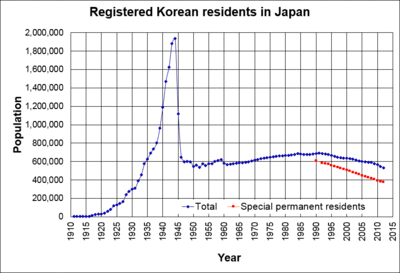
Back الكوريون في اليابان Arabic Koreanische Minderheit in Japan German Coreanos en Japón Spanish کرهایها در ژاپن Persian Japanin korealaiset Finnish Zainichi French Zainicsi Hungarian Orang Korea di Jepang ID Coreani in Giappone Italian 在日韓国・朝鮮人 Japanese
This article may require cleanup to meet Wikipedia's quality standards. The specific problem is: Scope of article and lead are misleading. Multiple groups of Koreans exist in Japan, one of which arrived after 1945. The title of the article implies encompassing all groups, not just the 1945 and before arrivals. (July 2024) |
 Koreans in Osaka, Japan in 1938 | |
| Total population | |
1,000,000 (total population including Koreans with Japanese citizenship)[1]
Details[3]
| |
| Regions with significant populations | |
| Tokyo (Shin-Ōkubo) · Osaka Prefecture (Ikuno-ku) | |
| Languages | |
| Japanese · Korean (Zainichi Korean) | |
| Religion | |
| Buddhism · Shinto/Korean Shamanism · Christianity · Irreligion | |
| Related ethnic groups | |
| Korean people · Sakhalin Koreans |
| Koreans in Japan | |||||||
|---|---|---|---|---|---|---|---|
| North Korean name | |||||||
| Chosŏn'gŭl | 재일 조선인 | ||||||
| Hancha | 在日 朝鮮人 | ||||||
| |||||||
| South Korean name | |||||||
| Hangul | 재일 한국인 | ||||||
| Hanja | 在日 韓國人 | ||||||
| |||||||
| Japanese name | |||||||
| Kanji | 在日韓国・朝鮮人 | ||||||
| Kana | ざいにちかんこく・ちょうせんじん | ||||||
| |||||||
| Part of a series on |
| Koreans in Japan |
|---|

Koreans in Japan (在日韓国人・在日本朝鮮人・朝鮮人, Zainichi Kankokujin/Zainihon Chōsenjin/Chōsenjin)' (Korean: 재일 한국/조선인) are ethnic Koreans who immigrated to Japan before 1945 and are citizens or permanent residents of Japan, or who are descendants of those immigrants. They are a group distinct from South Korean nationals who have immigrated to Japan since the end of World War II and the division of Korea.
They currently constitute the second largest ethnic minority group in Japan after Chinese immigrants, due to many Koreans assimilating into the general Japanese population.[4] The majority of Koreans in Japan are Zainichi Koreans (在日韓国・朝鮮人, Zainichi Kankoku/Chōsenjin), often known simply as Zainichi (在日, lit. 'in Japan'), who are ethnic Korean permanent residents of Japan. The term Zainichi Korean refers only to long-term Korean residents of Japan who trace their roots to Korea under Japanese rule, distinguishing them from the later wave of Korean migrants who came mostly in the 1980s,[5] and from pre-modern immigrants dating back to antiquity who may themselves be the ancestors of the Japanese people.[6]
The Japanese word "Zainichi" itself means a foreign citizen "staying in Japan", and implies temporary residence.[7] Nevertheless, the term "Zainichi Korean" is used to describe settled permanent residents of Japan, both those who have retained their Joseon or North Korean/South Korean nationalities, and even sometimes includes Japanese citizens of Korean descent who acquired Japanese nationality by naturalization or by birth from one or both parents who have Japanese citizenship.
- ^ "Koreans in Japan". Minority Rights Group. Archived from the original on 2024-09-03..
- ^ "令和5年末現在における在留外国人数について". Archived from the original on 2024-05-30. Retrieved 2024-04-01.
- ^ a b "在留外国人統計(旧登録外国人統計) 在留外国人統計 月次 2023年6月 | ファイル | 統計データを探す". Archived from the original on 2023-12-18. Retrieved 2023-12-18.
- ^ Statistics Bureau, Ministry of Internal Affairs and Communications (July 2021). "国籍・地域別 在留資格(在留目的)別 在留外国人" [Foreigners by nationality and by visas (occupation)]. Archived from the original on 2024-09-03. Retrieved 2021-08-15.
- ^ Hester, Jeffry T. (2008). "Datsu Zainichi-ron: An emerging discourse on belonging among Ethnic Koreans in Japan". In Nelson H. H.; Ertl, John; Tierney, R. Kenji (eds.). Multiculturalism in the new Japan: crossing the boundaries within. Berghahn Books. p. 144–145. ISBN 978-1-84545-226-1.
- ^ Diamond, Jared (June 1, 1998). "In Search of Japanese Roots". Discover Magazine. Archived from the original on September 2, 2019. Retrieved February 20, 2018.
- ^ Fukuoka, Yasunori; Gill, Tom (2000). Lives of young Koreans in Japan. Trans-Pacific Press. p. xxxviii. ISBN 978-1-876843-00-7.